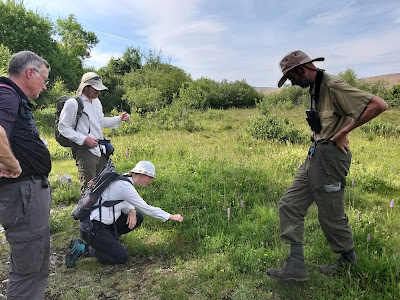 |
| Red Dead-nettle by flashlight Image: G. Scollard |
Once the sun was up, botanists were out hunting from Guernsey (31 species recorded, including Lesser Celandine, Pellitory-of-the-wall and and Common Dog-violet) up to Westray in the Orkney archipelago (4 species including Sea Mayweed) and from Earlham Cemetery in Norwich (21 species including Winter Aconite and Common Fumitory) over to Galway in the west of Ireland (8 species including Great Mullein and Yarrow).
Our intrepid plant-hunters wandered along country lanes, around urban industrial estates and car parks, and into cemeteries, peering at road verges and pavement cracks, looking for wild and naturalised plants in bloom.
 |
| Leicester botanists chuffed to find Annual Mercury blooming on an industrial estate Image: L. Marsh |
By around 10pm, the Results page was showing that 836 unique records had been submitted and 169 species recorded, with Daisy, Dandelion and Groundsel (aka the Usual Suspects) topping the list of most frequently recorded plants.
Botany groups out hunting in Somerset and the Bristol area, and ace botanists such as Paul Green, BSBI Ireland Officer, hunting in Co. Wexford, notched up some of the longest lists.
But as Moira from the New Year Plant Hunt Support Team reminded people, the Hunt isn't about competing for longest lists, it's about recording which plants are in bloom so we can compare across the years and against Met Office data, and learn more about how a changing climate is impacting our wildflowers. The Hunt is great fun but it's also an important Citizen Science initiative... with optional cake and hot chocolate ;-)
 |
| Jack and Florence consult Francis Rose's Wildflower Key to check the Ragwort that Florence found: it was an Oxford Ragwort. Image: L. Marsh |
If you haven't made plans yet to go out hunting, and you'd appreciate some company, try contacting your BSBI County Recorder to find out if there are any group hunts happening in your area, or check our New Year Plant Hunt Facebook group.
You can also go out on your own, with family and friends or follow the example of Kerry botanist Jessica Hamilton and head out with a canine companion or two.
Happy hunting - we can't wait to hear about what you find tomorrow!










.jpg)
.jpg)
.jpg)





























